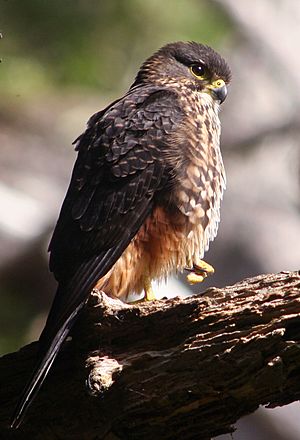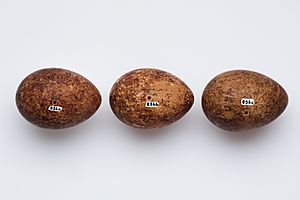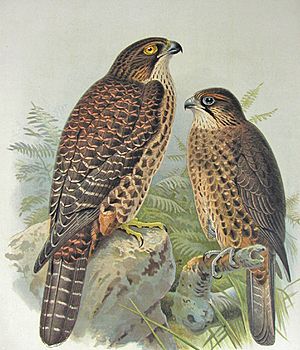New Zealand falcon facts for kids
Quick facts for kids New Zealandic falcon |
|
|---|---|
 |
|
| Conservation status | |
| Scientific classification | |
| Genus: |
Falco
|
| Species: |
novaeseelandiae
|
The New Zealand falcon (called kārearea by Māori people) is New Zealand's only true falcon. People sometimes call it the bush hawk or sparrow hawk. It is often confused with the larger swamp harrier, but the falcon is much smaller. Sadly, the kārearea is New Zealand's most endangered bird of prey. There are only about 3,000 to 5,000 breeding pairs left.
Contents
Meet the New Zealand Falcon
Scientists have studied the New Zealand falcon for a long time. They used to think it was a type of hobby or related to three South American falcons. But new studies show it is most closely related to the Aplomado falcon from South America.
There are two main types of New Zealand falcons. One type lives in the South Island and is larger. The other type lives in the North Island and is smaller. Even though they are very similar, their different sizes help them live in their specific environments. Because of this, people who work to protect them try to keep the North Island and South Island groups separate.
What Does the Falcon Look Like?
The New Zealand falcon is a medium-sized bird. Its wings can spread between 63 cm (25 inches) and 98 cm (39 inches) wide. It usually weighs less than 450 grams (about 1 pound). This makes it about half the size of the swamp harrier.
Falcons are very brave and will often attack a swamp harrier if they see one. Unlike the swamp harrier, the New Zealand falcon catches other birds while flying. It rarely eats dead animals. Male falcons are usually about two-thirds the weight of the females.
Where Do Falcons Live?
New Zealand falcons mostly live in thick forests and the steep mountains of the South Island. You rarely see them north of the central part of the North Island. A small group of these falcons also lives on the Auckland Islands. We know from old fossils that they once lived on the Chatham Islands too.
Falcon Behaviour
The New Zealand falcon is a very aggressive bird. It protects its home fiercely. There have been reports of falcons attacking dogs and even people who get too close to their territory.
Falcon Reproduction and Nests

New Zealand falcons build their nests in simple scrapes on the ground. They might choose a spot under a rock on a steep hill or on a rock ledge. Sometimes they nest among plants on a tree branch, or under a log on the ground. They lay two or three eggs.
Because their nests are often on the ground, the eggs are easy targets for predators. Animals like stray cats, stoats, weasels, possums, and wild dogs can easily find and eat the eggs.
Falcons and People
The kārearea has been a protected species since 1970. However, it is still a threatened bird. There are fewer than 8,000 birds left in total. Sadly, many falcons are harmed by people. Farmers and pigeon owners sometimes see them as a problem. Up to three-quarters of young falcons die in their first year. Most of these deaths are caused by human actions.
Falcons Help Grape Growers
In 2005, a special program started to help both falcons and grape farmers. The government helped fund this project. The idea was to use falcons to scare away other birds that eat grapes in vineyards. This program also helps to watch the falcons and create new breeding groups near the Marlborough wine region.
At first, four falcons were moved from the nearby hills to the vineyards. Later, 15 more birds were released. After this, the falcons started to breed there. This was the first time they were thought to have bred in that area in about 150 years!
The Cardrona Kārearea Conservation Project
The Cardrona Valley in the South Island has a small group of kārearea. A five-year project began in 2019 to help these birds. The project aims to collect information about the falcons. They want to know where they are seen, find breeding pairs, and watch their nests. This helps them learn about the number of breeding birds, how they use their habitat, and how big their territories are.
Danger from Power Lines
A big danger for these birds is electrocution from power lines. A study in Marlborough that tracked released birds showed this. Another study in Glenorchy also found that nearly half of the falcon deaths were caused by electrocution. This happens when they touch 11,000-volt power lines or electrical equipment.
Bird of the Year
The kārearea was voted "Bird of the Year" in 2012. This competition is run by the Forest & Bird group. It helps people learn about New Zealand's native birds, where they live, and the dangers they face.
Images for kids
See also
 In Spanish: Halcón maorí para niños
In Spanish: Halcón maorí para niños




